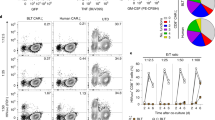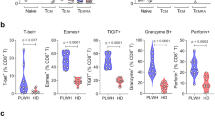Abstract
Immune-based approaches of cell therapy against viral pathogens such as the human immunodeficiency virus type 1 (HIV-1) could be of primary importance for the control of this viral infection. Here, we designed a chimeric cell surface receptor (105TCR) to provide primary human T-lymphocytes with antibody-type specificity for the HIV-1 envelope glycoprotein. This receptor includes the single chain Fv domain of the neutralizing anti-gp120 human monoclonal antibody F105, CD8α hinge and the transmembrane and the cytoplasmic domains of TCRζ. Our results show that 105TCR is expressed at the cellular surface and is capable of recognizing the HIV-1 envelope glycoprotein inducing highly efficient effector T-cell responses, including extracellular signal-regulated kinase phosphorylation and cytokine secretion. Moreover, human primary CD8+ T-lymphocytes transduced by oncoretroviral and lentiviral vectors containing the 105TCR gene are able to mediate in vitro-specific cytolysis of envelope-expressing cells and HIV-1-infected CD4+ T-lymphocytes. These findings suggest that 105TCR is particularly suited for in vivo efficacy studies.
This is a preview of subscription content, access via your institution
Access options
Subscribe to this journal
Receive 12 print issues and online access
$259.00 per year
only $21.58 per issue
Buy this article
- Purchase on Springer Link
- Instant access to full article PDF
Prices may be subject to local taxes which are calculated during checkout








Similar content being viewed by others
References
Borrow P et al. Virus-specific CD8+ cytotoxic T-lymphocyte activity associated with control of viremia in primary human immunodeficiency virus type 1 infection. J Virol 1994; 68: 6103–6110.
Koup RA et al. Temporal association of cellular immune responses with the initial control of viremia in primary human immunodeficiency virus type 1 syndrome. J Virol 1994; 68: 4650–4655.
Borrow P et al. Antiviral pressure exerted by HIV-1-specific cytotoxic T lymphocytes (CTLs) during primary infection demonstrated by rapid selection of CTL escape virus. Nat Med 1997; 3: 205–211.
Jin X et al. Dramatic rise in plasma viremia after CD8(+) T cell depletion in simian immunodeficiency virus-infected macaques. J Exp Med 1999; 189: 991–998.
Manca F et al. Anti-HIV genetic treatment of antigen-specific human CD4 lymphocytes for adoptive immunotherapy of opportunistic infections in AIDS. Gene Therapy 1997; 4: 1216–1224.
Manca F et al. Rational reconstitution of the immune repertoire in AIDS with autologous, antigen-specific, in vitro-expanded CD4 lymphocytes. Immunol Lett 1999; 66: 117–120.
Palù G et al. Genetically modified immunocompetent cells in HIV infection. Gene Therapy 2001; 8: 1593–1600.
Eshhar Z, Waks T, Gross G, Schindler DG . Specific activation and targeting of cytotoxic lymphocytes through chimeric single-chain consisting of antibody-binding domains and the γ or ζ subunits of the immunoglobulin and T cell receptors. Proc Natl Acad Sci USA 1993; 90: 720–724.
Altenschmidt U et al. Specific cytotoxic T lymphocytes in gene therapy. J Mol Med 1997; 75: 259–266.
Eshhar Z, Waks T, Bendavid A, Schindler DG . Functional expression of chimeric receptor genes in human T cells. J Immunol Methods 2001; 248: 67–76.
Becker ML et al. Expression of a hybrid immunoglobulin-T cell receptor protein in transgenic mice. Cell 1989; 58: 911–921.
Goverman J et al. Chimeric immunoglobulin-T cell receptor proteins form functional receptors: implications for T cell receptor complex formation and activation. Cell 1990; 60: 929–939.
Paillard F et al. Immunotherapy with T cells bearing chimeric antitumor receptors. Hum Gene Ther 1999; 10: 151–153.
Geiger TL, Leitenberg D, Flavell RA . The TCR-ζ chain immunoreceptor tyrosine-based activation motifs are sufficient for the activation and differentiation of primary T lymphocytes. J Immunol 1999; 162: 5931–5939.
Romeo C, Seed B . Cellular immunity to HIV activated by CD4 fused to T cell or Fc receptor polypeptides. Cell 1991; 64: 1037–1046.
Brocker T, Peter A, Traunecker A, Karjalainen K . New simplified molecular design for functional T cell receptor. Eur J Immunol 1993; 23: 1435–1439.
Eshhar Z . Tumor-specific T-bodies: towards clinical application. Cancer Immunol Immunother 1997; 45: 131–136.
Annenkov A, Chernajovsky Y . Engineering mouse T lymphocytes specific to type II collagen by transduction with a chimeric receptor consisting of a single chain Fv and TCR zeta. Gene Therapy 2000; 7: 714–722.
Roberts MR et al. Targeting of human immunodeficiency virus-infected cells by CD8+ T lymphocytes armed with universal T-cell receptors. Blood 1994; 84: 2878–2889.
Yang OO et al. Lysis of HIV-1-infected cells and inhibition of viral replication by universal receptor T cells. Proc Natl Acad Sci USA 1997; 94: 11478–11483.
Walker RE et al. Long-term in vivo survival of receptor-modified syngeneic T cells in patients with human immunodeficiency virus infection. Blood 2000; 96: 467–474.
Deeks SG et al. A phase II randomized study of HIV-specific T cell gene therapy in subjects with undetectable plasma viremia on combination antiretroviral therapy. Mol Ther 2002; 5: 788–797.
Mitsuyasu RT et al. Prolonged survival and tissue trafficking following adoptive transfer of CD4zeta gene-modified autologous CD4(+) and CD8(+) T cells in human immunodeficiency virus-infected subjects. Blood 2000; 96: 785–793.
Posner MR et al. An IgG human monoclonal antibody that reacts with HIV-1/gp120, inhibits virus binding to cells, and neutralizes infection. J Immunol 1991; 146: 4325–4332.
Thali M et al. Characterization of a discontinuous human immunodeficiency virus type 1 gp120 epitope recognized by a broadly reactive neutralizing human monoclonal antibody. J Virol 1991; 65: 6188–6193.
Matsuda S, Mariguchi T, Coyasu S, Nishida E . T lymphocyte activation signals for interleukin-2 production involve activation of MKK6-p38 and MKK7-SAPK/JNK signaling pathways sensitive to cyclosporin A. J Biol Chem 1998; 273: 12378–12382.
Whitehurst CE, Boulton TG, Cobb MH, Geppert TD . Extracellular signal-regulated kinases in T cells. Anti-CD3 and 4 beta-phorbol 12-myristate 13-acetate-induced phosphorylation and activation. J Immunol 1992; 148: 3230–3237.
Moore JP, Jarret RF . Sensitive ELISA for the gp120 and gp160 surface glycoprotein of HIV-1. AIDS Res Hum Retroviruses 1988; 4: 369–379.
Oh SK et al. Identification of HIV-1 envelope glycoproteins in the serum of AIDS and ARC patients. J Acquir Immune Defic Syndr 1992; 5: 251–256.
Hildinger M, Abe KL, Ostertag W, Baum C . Design of 5′ untranslated sequences in retroviral vectors develop for medical use. J Virol 1999; 73: 4083–4089.
Schambach A et al. Context dependence of different modules for posttranscriptional enhancement of gene expression from retroviral vectors. Mol Ther 2000; 2: 435–445.
Engels B et al. Retroviral vectors for high-level transgene expression in T lymphocytes. Human Gene Ther 2003; 14: 1155–1168.
Zufferey R et al. Self-inactivating lentivirus vector for safe and efficient in vivo gene delivery. J Virol 1998; 72: 9873–9880.
Miller AD et al. Construction and properties of retrovirus packaging cells based on gibbon ape leukemia virus. J Virol 1991; 65: 2220–2224.
Dull T et al. A third-generation lentivirus vector with a conditional packaging system. J Virol 1998; 72: 8463–8471.
Uckert W et al. Efficient gene transfer into primary human CD8+ T lymphocytes by MuLV-10A1 retrovirus pseudotype. Hum Gene Ther 2000; 11: 1005–1014.
Riddel SR, Greenberg PD . Principles for adoptive T cell therapy of human viral diseases. Ann Rev Immunol 1995; 13: 545–586.
Riddell SR, Greenberg PD . T-cell therapy of cytomegalovirus and human immunodeficiency virus infection. J Antimicrob Chemother 2000; 45 (Suppl T3): 35–43.
Mangasarian A et al. Nef-induced CD4 and major histocompatibility complex class I (MHC-I) down-regulation are governed by distinct determinants: N-terminal alpha helix and proline repeat of Nef selectively regulate MHC-I trafficking. J Virol 1999; 73: 1964–1973.
Piguet VL et al. HIV-1 Nef protein binds to the cellular protein PACS-1 to downregulate class I major histocompatibility complexes. Nat Cell Biol 2000; 2: 163–167.
Whitehurst CE, Geppert TD . MEK1 and the extracellular signal-regulated kinases are required for the stimulation of IL-2 gene transcription in T cells. J Immunol 1996; 156: 1020–1029.
Hege KM et al. Systemic T cell-independent tumor immunity after transplantation of universal receptor-modified bone marrow into SCID mice. J Exp Med 1996; 184: 2261–2269.
Yang OO et al. Nef-mediated resistance of human immunodeficiency virus type 1 to antiviral cytotoxic T lymphocytes. J Virol 2002; 76: 1626–1631.
Bitton N, Verrier F, Debre P, Gorochov G . Characterization of T cell-expressed chimeric receptors with antibody-type specificity for the CD4 binding site of HIV-1 gp120. Eur J Immunol 1998; 28: 4177–4187.
Patel SD et al. Impact of chimeric immune receptor extracellular protein domain on T cell function. Gene Therapy 1999; 6: 412–419.
Irving BA, Weiss A . The cytoplasmic domain of the T cell receptor zeta chain is sufficient to couple to receptor-associated signal transduction pathways. Cell 1991; 64: 891–901.
Maher et al. Human T-lymphocyte cytotoxicity and proliferation directed by a single chimeric TCRζ/CD28 receptor. Nature Biotech 2002; 20: 70–75.
Bitton N, Gorochov G, Debre P, Eshhar Z . Gene therapy approaches to HIV-infection: immunological strategies: use of T bodies and universal receptors to redirect cytolytic T-cells. Front Biosci 1999; 4: D386–D393; (review).
Gross G, Waks T, Eshhar Z . Expression of immunoglobulin-T-cell receptor chimeric molecules as functional receptors with antibody-type specificity. Proc Natl Acad Sci USA 1989; 86: 10024–10028.
Samino Y et al. An endogenous HIV envelope-derived peptide without the terminal NH3+ group anchor is physiologically presented by major histocompatibility complex class I molecules. J Biol Chem 2004; 279: 1151–1160.
Severino ME, Sarkis PTN, Walker BD, Yang OO . Chimerical immune receptor T cells bypass class I requirements and recognize multiple cell types relevant in HIV-1 infection. Virology 2003; 306: 371–375.
Banerjee R et al. Productive nonlytic human immunodeficiency virus type 1 replication in a newly established human leukemia cell line. Proc Natl Acad Sci USA 1992; 89: 9996–10000.
Cullen BR . Use of eukaryotic expression technology in the functional analysis of cloned genes. Methods Enzymol 1987; 152: 684–704.
Potter H, Weir L, Leder P . Enhancer-dependent expression of human kappa immunoglobulin genes introduced into mouse pre-B lymphocytes by electroporation. Proc Natl Acad Sci USA 1984; 81: 7161–7165.
Weissman AM et al. Molecular cloning of the zeta chain of the T cell antigen receptor. Science 1988; 239: 1018–1021.
Zomoyska R et al. Two Lyt-2 polypeptides arise from a single gene by alternative splicing patterns of mRNA. Cell 1985; 43: 153–163.
Marasco WA et al. Characterization of the cDNA of a broadly reactive neutralizing human anti-gp120 monoclonal antibody. J Clin Invest 1992; 90: 1467–1478.
Marasco WA, Haseltine WA, Chen SY . Design, intracellular expression, and activity of a human anti-human immunodeficiency virus type 1 gp120 single-chain antibody. Proc Natl Acad Sci USA 1993; 90: 7889–7893.
Baum C et al. Novel retroviral vectors for efficient expression of the multidrug resistance (mdr-1) gene in early hematopoietic cells. J Virol 1995; 69: 7541–7547.
Fehse B et al. A novel ‘sort suicide’ fusion gene vector for T cell manipulation. Gene Therapy 2002; 9: 1633–1638.
Sodroski J et al. Role of the HTLV-III/LAV envelope in syncytium formation and cytopathicity. Nature 1986; 322: 470–474.
Jawetz E, Melnick JL, Adelberg EA . Serologic diagnosis and immunologic detection of virus infection. In: Jawetz E, Melnick JL, Adelberg EA (eds.) Review of Medical Microbiology. Lange Medical Publications: Los Altos, 1980, pp 371–385.
Acknowledgements
We thank F Salandin for artwork. This work was supported by AIDS grants from the Istituto Superiore di Sanità (Rome-AIDS Projects no. 40D.64 to GP and no. 30D.60 to CP), the Fondazione Cassa di Risparmio di Padova e Rovigo, Regione Veneto, MIUR, FIRB, CNR Target Project on Biotechnology and AIRC.
Author information
Authors and Affiliations
Rights and permissions
About this article
Cite this article
Masiero, S., Del Vecchio, C., Gavioli, R. et al. T-cell engineering by a chimeric T-cell receptor with antibody-type specificity for the HIV-1 gp120. Gene Ther 12, 299–310 (2005). https://doi.org/10.1038/sj.gt.3302413
Received:
Accepted:
Published:
Issue Date:
DOI: https://doi.org/10.1038/sj.gt.3302413
Keywords
This article is cited by
-
Molecular mechanisms by which the HIV-1 latent reservoir is established and therapeutic strategies for its elimination
Archives of Virology (2023)
-
Quarter Century of Anti-HIV CAR T Cells
Current HIV/AIDS Reports (2018)
-
HIV-1 functional cure: will the dream come true?
BMC Medicine (2015)
-
Engineering T Cells to Functionally Cure HIV-1 Infection
Molecular Therapy (2015)
-
Immune reconstitution of acquired immune deficiency syndrome
Chinese Journal of Integrative Medicine (2010)



